Palmanova Cathedral – Duomo di Palmanova
- Maria Scuor
- Sep 26
- 6 min read
Scorri a basso per l’italiano
The cathedral or Duomo di Palmanova is also known as La chiesa del Santissimo Redentore (The Church of the Most Holy Redeemer). It is the main place of Catholic worship in Palmanova and dedicated to the Redeemer, Saint Mark and Saint Justina. The construction of late Renaissance and Baroque style church started in 1603, however due to lack of funds and conflicts between the Papal State and Venice as well as the Patriarchate of Aquileia meant it wasn’t completed until 1636. The bell tower was completed in 1776 and the church consecrated on June 15th, 1777.
The cathedral overlooks Piazza Grande and is the most magnificent building in the piazza. The white façade is made of white and gray stone. It is divided into two rows of four semi-columns, topped by a central oculus with a lion of St. Mark, a symbol of the Republic of Venice. The original lion was removed by the French in 1797 and therefore this one was cast in bronze in 1894 to replace it. In 1693 the statues of Saint Mark and Saint Justina were added on each side and the Redeemer (Jesus) was placed on the centre of the façade. To the left there is a reduced height bell tower which prevented the building being exposed to the enemy.
Inside the cathedral has a single nave with wooden trusses made of durmast beams. There are three apses with a neoclassical high altar that dates back to 1854. The original wooden altar that was built in 1645 was placed a few meters inside the apse as it is deteriorating. The statues of white lacquered wood depict Saint Mark with a winged lion and the martyr Saint Justina with the palm of martyrdom. The choir dates back to the 17th century and was restored to include backrests, kneelers, and seats which have decorated moldings, cornices and carvings. There is the altarpiece of Christ, at the centre of the apse and numerous paintings and frescos around the apse.
To the left is the Chapel of the Madonna del Carmine and has the original wooden altar was built in1630 but replaced with the current Carrara marble one in 1905. The wooden sculpture on the altar houses the Madonna with Baby Jesus and is from the 16th-century and comes from one of the churches in the surrounding villages.
To the right is the Chapel of the Blessed sacrament which was once dedicated to the Holy Rosary. It has a Carrara marble altar, Verona marble steps, African marble columns and a predella made of Carrara and Bardiglio marble cubes. The fresco on the vault was painted by Domenico Fabris in 1861. This chapel also is adorned with many paintings.
There are four altars on the side walls:
Altar of the Militias: Built in 1640 and features four columns of black Timau marble surmounted by four Doric capitals
Altar of the Crucifix: Built in 1645 and is opposite the Militia altar, was originally dedicated to the Crucifix. The original altarpiece was lost and replaced by a canvas depicting Our Lady of the Rosary in 1833
Altar of the Holy Family: Built in 1645 and is the first altar on the right when we first enter the cathedral. The urn-shaped altar frontal was commissioned in 1684. On the left side there are wooden doors which open to the effigy of Saint Justina to the faithful. The canvas above the altar is the work of Eugenio Pini and was created in 1645
Altar of the Annunciation: The original wooden altar built in 1643 was replaced in 1820 by a polychrome marble one that dates back to the 17th century. The canvas is the work of Pompeo Randi of Forli and dates back to 1878.
The original organ and choir stalls were built on the left wall of the cathedral in 1648. The original instrument was sold in 1811 and replaced by the current one. The latest modification was done in 1979. Both the playing and register action are mechanical. The manuals has 54 keys while the pedal has 27.
Truly a beautiful cathedral that overlooks a spectacular piazza full of history and beauty.
Exterior - Esterno
Interior - Interno
Duomo di Palmanova
Il Duomo di Palmanova è conosciuta anche come La chiesa del Santissimo Redentore. È il principale luogo di culto cattolico a Palmanova ed è dedicato al Redentore, a San Marco e a Santa Giustina. La costruzione della chiesa in stile tardo rinascimentale e barocco iniziò nel 1603, ma a causa della mancanza di fondi e dei conflitti tra lo Stato Pontificio e Venezia, nonché il Patriarcato di Aquileia, non fu completata fino al 1636. Il campanile fu completato nel 1776 e la chiesa consacrata il 15 giugno 1777.
La cattedrale si affaccia su Piazza Grande ed è l'edificio più magnifico della piazza. La facciata bianca è realizzata in pietra bianca e grigia. E' diviso in due file di quattro semicolonne, sormontate da un oculo centrale con un leone di San Marco, simbolo della Repubblica di Venezia. Il leone originale fu rimosso dai francesi nel 1797 e quindi questo fu fuso in bronzo nel 1894 per sostituirlo. Nel 1693 furono aggiunte ai lati le statue di San Marco e Santa Giustina e al centro della facciata fu collocato il Redentore (Gesù). A sinistra si trova un campanile di altezza ridotta che impediva l'esposizione dell'edificio al nemico.
All'interno la cattedrale è a navata unica con capriate lignee in travi di rovere. Le absidi sono tre con un altare maggiore neoclassico che risale al 1854. L'altare ligneo originale che fu costruito nel 1645 era collocato a pochi metri all'interno dell'abside in quanto si sta deteriorando. Le statue in legno laccato bianco raffigurano San Marco con il leone alato e la martire Santa Giustina con la palma del martirio. Il coro risale al XVII secolo ed è stato restaurato per includere schienali, inginocchiatoi e sedili che hanno modanature decorate, cornici e intagli. Al centro dell'abside si trova la pala d'altare del Cristo e numerosi dipinti e affreschi.
A sinistra si trova la Cappella della Madonna del Carmine e l'altare ligneo originale fu costruito nel 1630 ma sostituito con l'attuale altare in marmo di Carrara nel 1905. La scultura lignea sull'altare ospita la Madonna con Gesù Bambino ed è del XVI secolo e proviene da una delle chiese dei paesi circostanti.
A destra si trova la Cappella del Santissimo Sacramento, un tempo dedicata al Santo Rosario. Ha un altare in marmo di Carrara, gradini in marmo di Verona, colonne in marmo africano e una predella in cubi di marmo di Carrara e Bardiglio. L'affresco della volta fu affrescato da Domenico Fabris nel 1861. Anche questa cappella è adornata con molti dipinti.
Sulle pareti laterali si trovano quattro altari:
Altare delle Milizie: Costruito nel 1640 e caratterizzato da quattro colonne di marmo nero di Timau sormontate da quattro capitelli dorici
Altare del Crocifisso: Costruito nel 1645 e di fronte all'altare della Milizia, era originariamente dedicato al Crocifisso. La pala d'altare originale andò perduta e sostituita da una tela raffigurante la Madonna del Rosario nel 1833
Altare della Sacra Famiglia: Costruito nel 1645 ed è il primo altare a destra quando entriamo per la prima volta nella cattedrale. Il paliotto d'altare a forma di urna fu commissionato nel 1684. Sul lato sinistro si aprono porte lignee che aprono ai fedeli l'effige di Santa Giustina. La tela sopra l'altare è opera di Eugenio Pini e fu realizzata nel 1645
Altare dell'Annunziata: L'altare ligneo originario costruito nel 1643 fu sostituito nel 1820 da uno in marmi policromi risalente al XVII secolo. La tela è opera di Pompeo Randi di Forlì e risale al 1878.
L'organo originale e gli stalli del coro furono costruiti sulla parete sinistra della cattedrale nel 1648. Lo strumento originale fu venduto nel 1811 e sostituito da quello attuale. L'ultima modifica è stata apportata nel 1979. Sia l'esecuzione che l'azione di registro sono meccaniche. Il manuale ha 54 tasti mentre il pedale ne ha 27.
Veramente una bellissima cattedrale che si affaccia su una piazza spettacolare ricca di storia e bellezza.






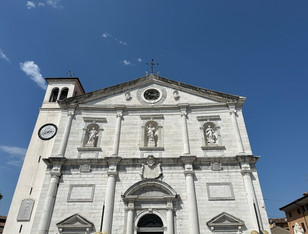





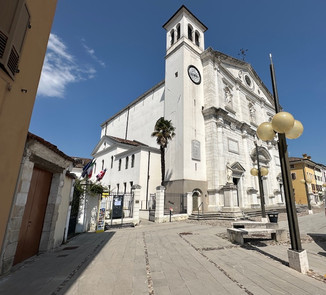

















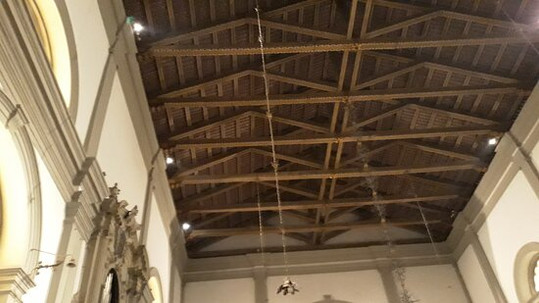







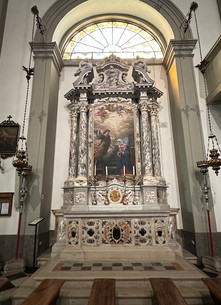




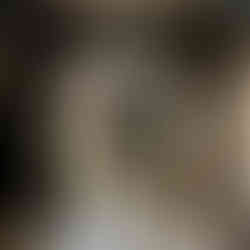











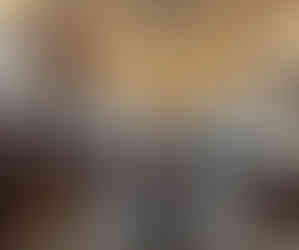


























Comments